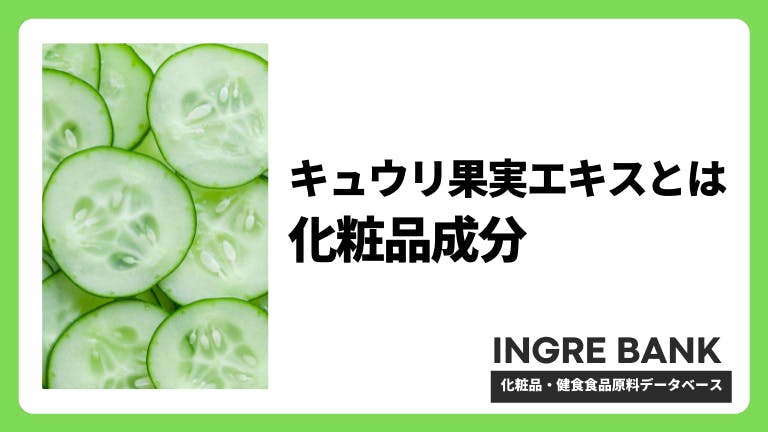表示名称成分詳細
キュウリ果実エキス
成分番号(JP number): 556875
- INCI
- CUCUMIS SATIVUS FRUIT EXTRACT
- 定義(Description)
- 本品は、キュウリ Cucumis sativusの果実のエキスである。Cucumis Sativus Fruit Extract is an extract of the fruit of the Cucumber, Cucumis sativus L., Cucurbitaceae
- 日本の規制情報(Japanese regulation information)
- 中文inci(CN/中国名称)
- 黄瓜(CUCUMIS SATIVUS)果提取物
- 中国の規制情報(Chinese regulation information)
- 【已使用化妆品原料目录(2021年版)】Maximum Historical Usage in Rinse-off Cosmetics(%): 20, Maximum Historical Usage in Leave-on Cosmetics(%): 20
- 韓国inci(KR/ハングル/성분명)
- 오이열매추출물
- CAS No.
- 89998-01-06
- EC No.
- 289-738-4
- EUの規制情報(Restriction/Annex/Ref#)
-
原料情報

キュウリ果実エキス / CUCUMIS SATIVUS FRUIT EXTRACT
キュウリ果実エキスとは
キュウリ果実エキスは、ウリ科植物キュウリ(学名:Cucumis sativus、英名:Cucumber)の果実から得られる植物エキスです。淡黄色透明の液体で、キュウリ特有の芳香があります。
キュウリはインド北西部およびヒマラヤ南麓原産で蔓性の一〜二年草です。キュウリは夏野菜の代表と言えますが、日本では一年中栽培されており日常的に食されています。
西部アジアでは3000年以上も前から栽培され、紀元1世紀のはじめにはギリシャ、ローマ、小アジア、北アフリカにて栽培されていたと考えられています。日本には10世紀以前に渡来し、現存する文献では『本草和名』(918)にキュウリの名がはじめてみられ、小型で多汁なことが記されています(1)。
生薬としてのキュウリ果実
キュウリの果実を採取し、薄く輪切りにして日干しにしたものは生薬として胡瓜(こか)と呼ばれています。腎炎や脚気などで体にむくみがある時は胡瓜を煎用すると効果があります(2)。
キュウリには利尿作用があるカリウムが多く含まれており、体内の過剰なナトリウムを排出する作用があります。老廃物、毒素も排出して血液を浄化し、血液と細胞の働きを正常化します(3)。
また外用では、キュウリの熱を取り去る作用から、火傷やあせも、にきびなどの患部にキュウリエキスをつけると効き目があります(3)。
キュウリ果実エキスの成分には、
・糖類:スクロース、グルコース、フルクトース
・有機酸:リンゴ酸、フマル酸、クエン酸
・ビタミン類:カロテン、ビタミンC
などが含まれています(4)。
キュウリ果実エキスの化粧品への配合
キュウリ果実エキスは日本でも古くからヘチマ水と共に洗顔水として用いられてきました。キュウリエキスにはビタミンCをはじめ多くのビタミン類やリンゴ酸などの有機酸も含有されています。
ビタミンCのもつ美肌作用や有機酸のもつ収れん作用などにより、色黒の予防や、肌をひきしめ、つやとハリを与え、皮膚の水分を保って肌荒れ、小じわなどを防ぐ作用があります(5)。保湿作用にも優れているので、乾燥から肌を守る化粧品に配合されます(6)。
参考文献
(1) 農山漁村文化協会 (1988)「キュウリ:植物としての特性」野菜園芸大百科 キュウリ第一巻 3-5
(2) 田中孝治, 他 (2002)「キュウリ」家庭で使える薬用植物大事典, 89
(3) 東城百合子 (2019)「キュウリ」自然治癒力をひきだす「野草と野菜」のクスリ箱, 83
(4) 杉田 浩一, 他 (2013)「キュウリ」日本食品大事典 第3版, 130-132
(5) 鈴木一成 (2008)「キュウリエキス」化粧品成分用語事典2008, 212
(6) 宇山 光男, 他 (2015)「キュウリ」化粧品成分ガイド 第6版, 196
キュウリ果実エキスの配合目的
- 美肌作用
- 収れん作用
- 保湿作用
キュウリ果実エキスの安全性情報
Cosmetic Ingredient Review (2014)「Safety Assessment of Cucumis sativus (Cucumber)-Derived Ingredients as Used in Cosmetics」International Journal of Toxicology (33) (Suppl_2), 47S-64S
日本語論文
酵母由来の活性水で元気なキュウリ-肌にもいいし、飲んでもいい--茨城県筑西市・野菜村 (特集 身体に作物に発酵の恵み プクプク酵母菌の世界へ) -- (プクプク酵母は作物との相性バツグン)
現代農業 85(12), 98-102, 2006-12
葉面散布効果も期待 肌しっとりキュウリ水のふしぎ (特集 生命(いのち)の水 樹液をいただく) -- (ウリ類の樹液)
松沼 憲治 現代農業 83(3), 66-68, 2004-03
英語論文
Allergenic Ingredients in Facial Wet Wipes.
Aschenbeck KA, Warshaw EM.Dermatitis. 2017 Nov/Dec;28(6):353-359. doi: 10.1097/DER.0000000000000268.PMID: 28338538
Vats M, Bhardwaj S, Chhabra A.Endocr Metab Immune Disord Drug Targets. 2021;21(4):726-733. doi: 10.2174/1871530320666200705212107.PMID: 32628604
Cucumis sativus fruit-potential antioxidant, anti-hyaluronidase, and anti-elastase agent.
Nema NK, Maity N, Sarkar B, Mukherjee PK.Arch Dermatol Res. 2011 May;303(4):247-52. doi: 10.1007/s00403-010-1103-y. Epub 2010 Dec 14.PMID: 21153830
Safety Assessment of Cucumis sativus (Cucumber)-Derived Ingredients as Used in Cosmetics.
Fiume MM, Bergfeld WF, Belsito DV, Hill RA, Klaassen CD, Liebler DC, Marks JG Jr, Shank RC, Slaga TJ, Snyder PW, Andersen FA.Int J Toxicol. 2014 May;33(2 suppl):47S-64S. doi: 10.1177/1091581814526892. Epub 2014 May 26.PMID: 24861368
Zhong X, Downs CA, Li Y, Zhang Z, Li Y, Liu B, Gao H, Li Q.Sci Total Environ. 2020 Apr 20;714:136879. doi: 10.1016/j.scitotenv.2020.136879. Epub 2020 Jan 22.PMID: 32018996
Nafeesa Z, Shivalingu BR, Neema KN, Achar RR, Venkatesh BK, Hanchinal V, Priya BS, Nanjunda Swamy S.3 Biotech. 2017 Jun;7(2):96. doi: 10.1007/s13205-017-0686-9. Epub 2017 May 29.PMID: 28555432 Free PMC article.
Zhong X, Li Y, Che X, Zhang Z, Li Y, Liu B, Li Q, Gao H.Chemosphere. 2019 Mar;219:456-462. doi: 10.1016/j.chemosphere.2018.12.019. Epub 2018 Dec 3.PMID: 30551112
CeO2 and ZnO nanoparticles change the nutritional qualities of cucumber (Cucumis sativus).
Zhao L, Peralta-Videa JR, Rico CM, Hernandez-Viezcas JA, Sun Y, Niu G, Servin A, Nunez JE, Duarte-Gardea M, Gardea-Torresdey JL.J Agric Food Chem. 2014 Apr 2;62(13):2752-9. doi: 10.1021/jf405476u. Epub 2014 Mar 21.PMID: 24611936
Servin AD, Castillo-Michel H, Hernandez-Viezcas JA, Diaz BC, Peralta-Videa JR, Gardea-Torresdey JL.Environ Sci Technol. 2012 Jul 17;46(14):7637-43. doi: 10.1021/es300955b. Epub 2012 Jul 5.PMID: 22715806
Zhang R, Zhang H, Tu C, Hu X, Li L, Luo Y, Christie P.Environ Sci Pollut Res Int. 2015 Jul;22(14):11109-17. doi: 10.1007/s11356-015-4325-x. Epub 2015 Mar 22.PMID: 25794580
Influence of metal oxide particles on soil enzyme activity and bioaccumulation of two plants.
Kim S, Sin H, Lee S, Lee I.J Microbiol Biotechnol. 2013 Sep 28;23(9):1279-86. doi: 10.4014/jmb.1304.04084.PMID: 23751560
Effect of nanoscale Fe(3)O(4), TiO(2) and carbon particles on cucumber seed germination.
Mushtaq YK.J Environ Sci Health A Tox Hazard Subst Environ Eng. 2011;46(14):1732-5. doi: 10.1080/10934529.2011.633403.PMID: 22175877
In vivo nanotoxicity assays in plant models.
Kumari M, Ernest V, Mukherjee A, Chandrasekaran N.Methods Mol Biol. 2012;926:399-410. doi: 10.1007/978-1-62703-002-1_26.PMID: 22975978
Liang Q, Wei L, Xu B, Liu L, Calderón-Urrea A.Plant Dis. 2020 Sep 23. doi: 10.1094/PDIS-04-20-0703-PDN. Online ahead of print.PMID: 32967556
Sun C, Dudley S, Trumble J, Gan J.Environ Pollut. 2018 Mar;234:39-47. doi: 10.1016/j.envpol.2017.11.041. Epub 2017 Nov 20.PMID: 29156440
Suryawanshi RK, Patil CD, Borase HP, Narkhede CP, Stevenson A, Hallsworth JE, Patil SV.Int J Cosmet Sci. 2015 Feb;37(1):98-107. doi: 10.1111/ics.12175. Epub 2014 Nov 16.PMID: 2535475
Moghaddasi S, Fotovat A, Khoshgoftarmanesh AH, Karimzadeh F, Khazaei HR, Khorassani R.Ecotoxicol Environ Saf. 2017 Oct;144:543-551. doi: 10.1016/j.ecoenv.2017.06.074. Epub 2017 Jul 5.PMID: 28688355
Sahu RK, Roy A, Dwivedi J, Jha AK.Pak J Biol Sci. 2014 Jan 1;17(1):146-50. doi: 10.3923/pjbs.2014.146.150.PMID: 247837
Ahmed B, Rizvi A, Syed A, Jailani A, Elgorban AM, Khan MS, Al-Shwaiman HA, Lee J.Environ Pollut. 2021 Nov 15;289:117854. doi: 10.1016/j.envpol.2021.117854. Epub 2021 Jul 27.PMID: 343332
Nanoparticles affect the survival of bacteria on leaf surfaces.
Wang S, Chang LY, Wang YJ, Wang Q, Yang CH, Mei RH.FEMS Microbiol Ecol. 2009 May;68(2):182-91. doi: 10.1111/j.1574-6941.2009.00664.x.PMID: 19573199
Zhao L, Sun Y, Hernandez-Viezcas JA, Servin AD, Hong J, Niu G, Peralta-Videa JR, Duarte-Gardea M, Gardea-Torresdey JL.J Agric Food Chem. 2013 Dec 11;61(49):11945-51. doi: 10.1021/jf404328e. Epub 2013 Nov 23.PMID: 24245665
Servin AD, Morales MI, Castillo-Michel H, Hernandez-Viezcas JA, Munoz B, Zhao L, Nunez JE, Peralta-Videa JR, Gardea-Torresdey JL.Environ Sci Technol. 2013 Oct 15;47(20):11592-8. doi: 10.1021/es403368j. Epub 2013 Sep 27.PMID: 24040965
Development of formulations of biological agents for management of root rot of lettuce and cucumber.
Amer GA, Utkhede RS.Can J Microbiol. 2000 Sep;46(9):809-16. doi: 10.1139/w00-063.PMID: 11006841
[Cucumber extract in therapy of undesirable pigmentation].
BOAS H.Ugeskr Laeger. 1954 Dec 9;116(49):1731.PMID: 13238422 Danish. No abstract available.


